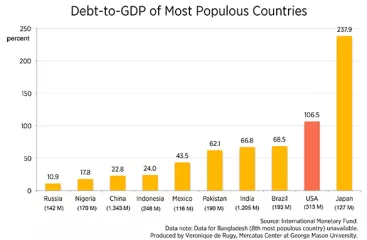- | Government Spending Government Spending
- | Data Visualizations Data Visualizations
- |
Beyond CBO’s Baseline Debt Projections
The Congressional Budget Office (CBO) recently released updated projections of the United States’ long-term budget outlook that confirm that we’ll be drowning in debt over the next couple of decades. This chart examines CBO's extended debt projections, which are estimates beyond the 10-year period covered by its regular baseline projections. This provides a more realistic picture of our fiscal outlook since it accounts for the harmful effects of debt on the economy, as well as lower levels of savings and revenue.
The Congressional Budget Office (CBO) recently released updated projections of the United States’ long-term budget outlook that confirm that we’ll be drowning in debt over the next couple of decades. This chart examines CBO's extended debt projections, which are estimates beyond the 10-year period covered by its regular baseline projections. This provides a more realistic picture of our fiscal outlook since it accounts for the harmful effects of debt on the economy, as well as lower levels of savings and revenue.
Accounting for these long-run economic changes, or what CBO's calls "economic feedback," and more realistic assumptions regarding the continuation of certain fiscal policies set to expire, the federal debt held by the public under CBO’s alternative scenario would reach about 190 percent of GDP by 2038. Under the alternative scenario, debt reaches 100 percent of GDP in 2028—ten years earlier than the widely reported 2038 date under the extended baseline scenario.
 Summary of findings about US public debt under various forecasting scenarios:
Summary of findings about US public debt under various forecasting scenarios:
- Baseline scenario: debt held by the public would reach 100 percent of GDP in 2038, 25 years from now, even without accounting for the harmful effects that growing debt would have on the economy.
- Baseline scenario with economic feedback (purple line): accounting for the way public debt would crowd out private investment, leading to lower federal revenues and higher interest payments, debt would rise to 108 percent of GDP in 2038.
- Alternative scenario with economic feedback (red line): incorporates the economic changes outlined above with the expectation that certain policies now in place but scheduled to change under current law would continue instead. Assuming that some provisions of current law that might be difficult to sustain for a long period would be modified, public debt would reach about 190 percent of GDP by 2038.
In spite of a real improvement of our fiscal outlook for the next few years, the realities of an unsustainable long-term fiscal path are undeniable and alarming. Yet some in Congress are discussing repealing the tiny short-term sequester cuts, while very few lawmakers are serious about the long-term challenges, such as reforming entitlement spending.
Lawmakers need to keep the skyrocketing trajectory of our debt in mind as they begin the debt ceiling talks this fall. It’s time to get serious about cutting spending.


